The best subwoofer riser is one that has a height of approximately two feet and is filled with fiber glass or mineral wool to act as a sub trap at the same time.
I also noticed that when I put four subwoofers on four risers that are 1.5 to 2 feet tall, there was a significant change in the total output. This change in output was not only noticeable in the sweet spot, but also in different locations in the room.
Important Facts About Subwoofers, Listeners, and Standing Waves- Subwoofers are sound pressure generators. They will reinforce the room modes when they are located in high pressure regions of the standing waves.
- Ears respond to sound pressure. When our heads are located in the high pressure regions of the standing waves, the room modes will be most audible.
- If the subwoofer is placed in the null areas, the corresponding modes will disappear.
- If you move your head to the null areas, you will not hear a lot of deep bass.
- Room dimensions and subwoofer location create room modes.
There is another factor that limits the remaining options for speaker placement. The pressure zones are spread out and not pinpoint-sized. For all practical purposes, the subwoofer should be located at least 25 percent away from the boundaries to best avoid stimulating any of its first three harmonics. There is no location towards the middle of the room that suits a subwoofer position, as the pressure zones there are overlapping.
Calculating the Resonance Modes of a Home Theater Room and Subwoofer Placement
Axial Modes are the strongest and the most important, and the easiest to compute. Tangential Modes are about half as loud, and Oblique Modes are about a quarter as loud. They tend to be the least important, but if an oblique room mode occurs near another mode, that frequency may still be a problem. It is best to calculate all room modes to see where any overlap may be.
For most rectangular home theater rooms, it may be sufficient to calculate only the axial modes of the room.
Since a room can enforce a wave twice as long as it is, the first fundamental frequency can be calculated by using the formula: Standing Wave Frequency = Speed of Sound / 2*Distance Between Boundaries. If we multiply this frequency by 2, we will get the second harmonic frequency and so on. Usually it is necessary only to look at the first three or four modes because the crossover frequency for most home theater rooms are set around 80Hz-100Hz. Let us now calculate the axial modes for a 15ft W x 20ft L x 8ft H room.
Width
The first resonance frequency: 1130ftps / 2x15ft = 37.7Hz.
The second resonance frequency: 37.7 x 2 = 75.4HZ.
The third resonance frequency: 37.7 x 3 = 113.1HZ, ignore, because it is above the croosover frequency of 85Hz. However, the LFE channel has frequencies up to 120Hz. So even this resonance frequency may play a role.
The subwoofer has to be placed at least 25 percent away from the wall (15x0.25=3.75ft) because of the first harmonic, but that is the point of minimum of the second harmonic. Therefore, the subwoofer can be placed anywhere between 3.75ft (minimum of the second harmonic) and 7.5ft (minimum of the first harmonic) away from either wall.
Length
The first resonance frequency: 1130ftps / 2x20ft = 28.3Hz.
The second resonance frequency: 28.3 x 2 = 56.6HZ.
The third resonance frequency: 28.3 x 3 = 84.9HZ.
Since all three harmonics are below the crossover frequency of 85Hz, we should place the subwoofer in a position that avoids the maximum and minimum of the three waves – at least 25% (20 x0.25=5ft) from either end walls.
Height
The first resonance frequency: 1130ftps / 2x8ft = 70.6Hz.
The second resonance frequency: 70.6 x 2 = 141.2HZ, ignore, because it is above the crossover frequency of 85Hz.
The third resonance frequency: 70.6 x 3 = 211.8HZ, ignore, because it is above the crossover frequency of 85Hz.
The vertical position for a subwoofer is anywhere in the middle half of the room, keeping it at least 25% (two) feet away from either the floor or ceiling.
If we raise the height of the ceiling to 10ft, the first resonance frequency drops to 56.5Hz and the second resonance frequency will be 113Hz. For a ceiling height of 12 ft, the first and second resonance frequencies will be 47Hz and 94Hz. Many people use their living rooms as their primary home theater. The ceiling height of some of these living rooms may be much higher than 8 feet. For example, if the ceiling height is 15ft, the first, second, and third resonance frequencies will be 38Hz, 75Hz, and 113Hz.
So, a 15ft W x 20ft L x 8ft H room will have the smoothest bass if the subwoofer is located 2ft from the floor or 2ft from the ceiling (6ft from the floor), between 3.75ft and 7.5ft from the side walls, and five feet from the end walls. This is done to avoid the coupling of the subwoofer to room modes.
The following is written by Art Noxon at ASC:
http://www.asc-hifi.com/articles.htm
Quote:
Feedback Control: The Science Behind The SubTrap
Arthur Noxon, President Of ASC/Inventor Of The TubeTrap
Feedback can happen in most any type of audio system, adding a howl or whistling tones to the program material. It happens when sound loops back into the electronics and generates some version of the original signal within the electronics. Feedback loops must be controlled to achieve accurate reproduction of the program material.
The most common form of feedback is electroacoustic. A good example of this is the howl of an open microphone on stage. It can be fixed by moving the microphone, changing its pick-up pattern or applying equalization (EQ). Mechanical-acoustic feedback (microphonics) is similar except that it occurs when vibration from a loudspeaker buzzes the electronic circuits or the transport of a record, CD, or DVD. A rumble or ragged tone is heard. Platform isolators can decouple the vibration conduction path.
Room-acoustic feedback occurs when loudspeakers couple with room modes. The subwoofer is particularly vulnerable to room-acoustic feedback, especially the vertical room mode. It colors the playback and blurs the articulation. Room-acoustic feedback control is essential in all quality audio playback environments.
Without room acoustic feedback control, the subwoofer couples to one or more room modes and gets so loud at those frequencies that the overall bass volume has to be turned down. But that also turns down the volume of the program material. The result is the “one note bass” effect, and it is the common shortfall in subwoofer performance.
To reduce mode coupling, the subwoofer can be moved around the room, but the basic problem, the vertical room mode, remains. For an 8-foot ceiling, the feedback resonance is at 70 Hz, right in the middle of the subwoofer response curve. EQ can be applied, but that only quiets the loudness of the mode coupling. The inarticulate slurring, the failure to present a fast tracking dynamic bass line, remains inadequate. The ASCSubTrap is a pre-engineered broadband acoustic feedback control system that directly addresses vertical mode coupling, regardless of ceiling height. It reduces the excessive loudness (one note bass) and improves the articulation (mud) normally associated with subwoofer placement on the floor.
The setup is almost too simple. Lift the subwoofer up and slip the SubTrap underneath- This raises the subwoofer up off the floor, out of the vertical mode pressure zone and decouples the subwoofer from being able to contact a pressure mode and pump energy into the mode.
- In addition, a bass trap has been located on the floor, right in the middle of the vertical mode pressure zone. Any vertical mode action that might be stimulated by the subwoofer is rapidly damped out.
- Finally, the SubTrap acts as an iso-deck, a floating platform to mechanically decouple the subwoofer vibration from the floor, electronic gear, video equipment and the rest of the house.
When vertical mode buildup is eliminated, the EQ can be turned off, and the subwoofer volume can be turned back up to match the main listening level. The subwoofer can finally do its job, which is to complete the full bandwidth presentation of dialogue, musical detail, and explosive program material.
|
























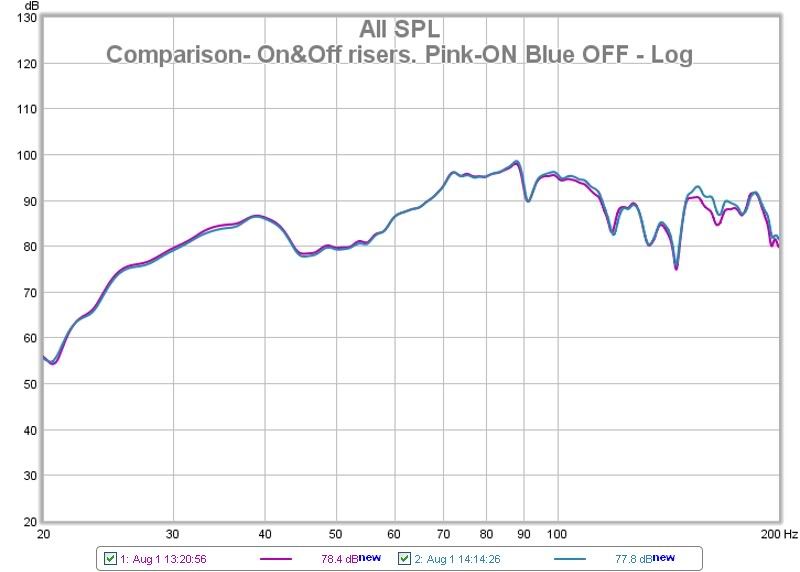
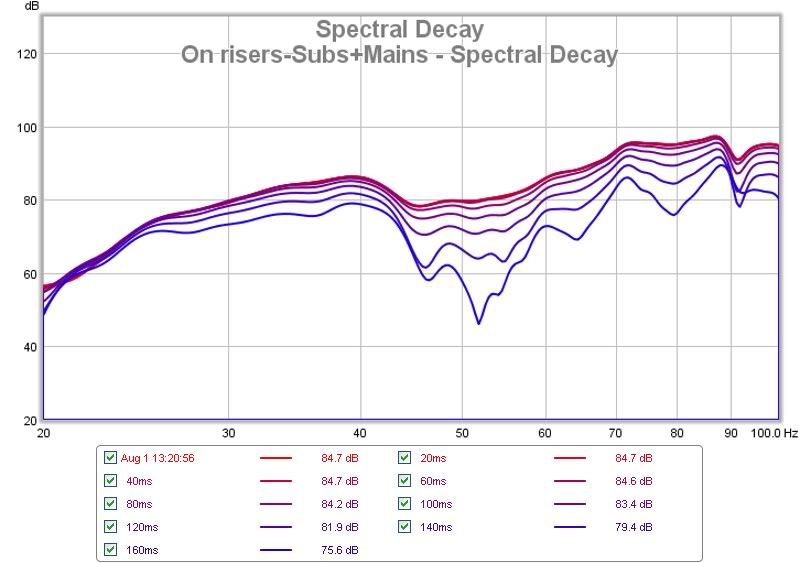
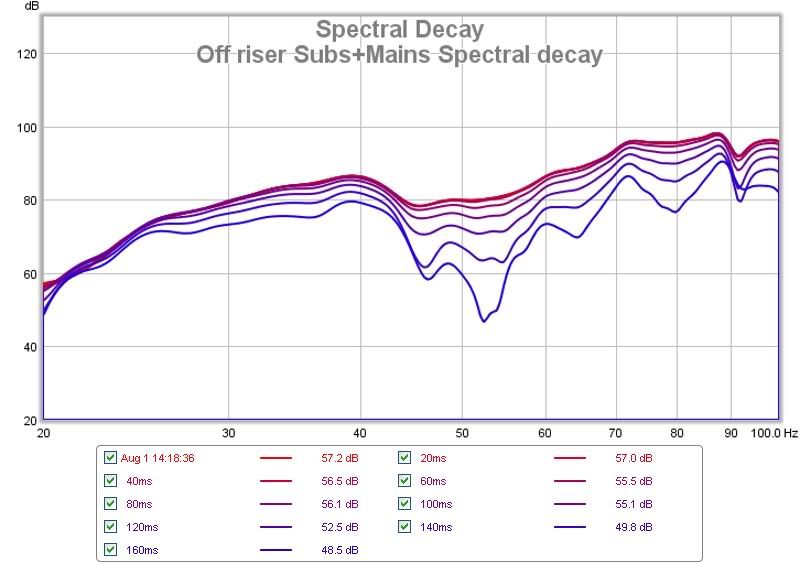
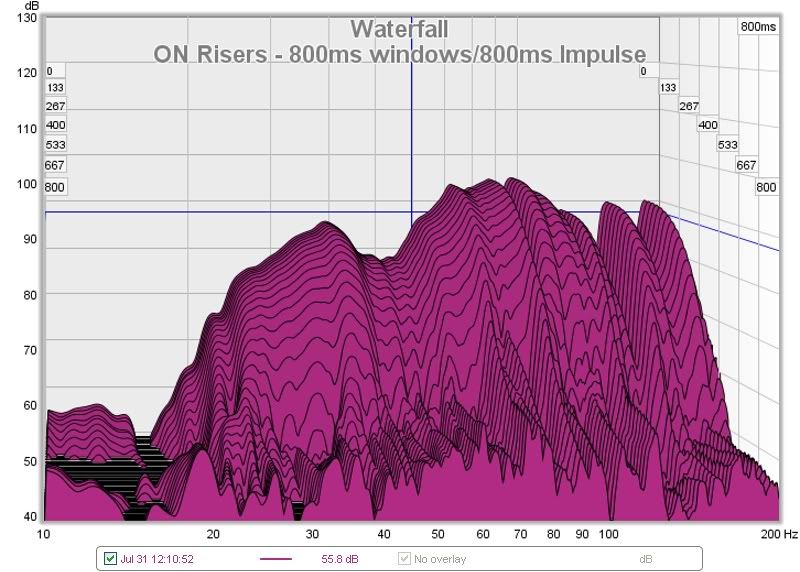
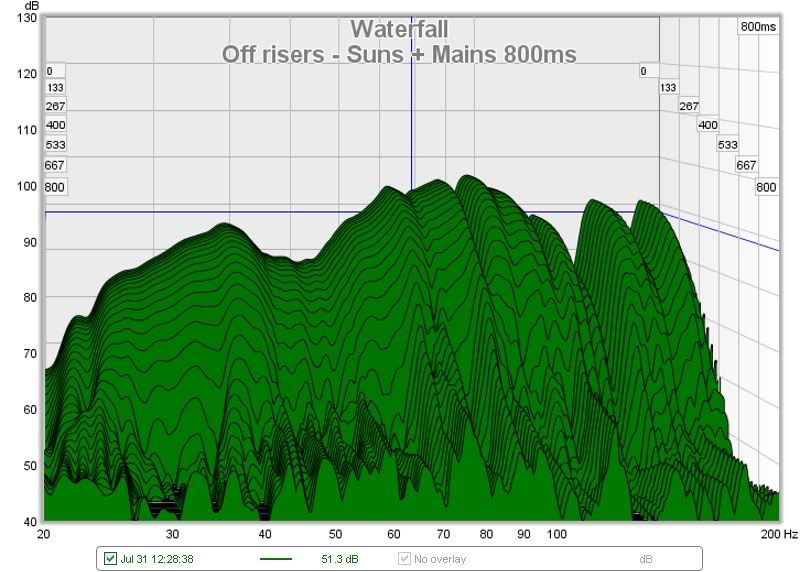





 Linear Mode
Linear Mode

